Navigating the Terrain of Dis/Ability: An Autoethnographic Cartography
Susan Docherty-Skippen, Faculty of Education
Brock University, Ontario
susan [dot] docherty-skippen [at] brocku.ca
Abstract: Through my lens as an adult educator with non-apparent dis/abilities, this paper has been constructed as an autoethnographic cartography in the lived experience of a dis/ability paradigm. Like a navigational pelorus used to sustain a vessel’s bearing at sea, the relative fluidity of my dis/abled identity, lost and found, has been charted against encounters and relapses of stroke and mental illness. Drawing from personal dis/ability narratives, I illustrate how I captured and studied the familiar yet unaccustomed geography of my body’s dis/abling experiences. I describe how the use of visually captivating, artistic underwater photographs of feminine bodies—strong—sensual—alive, and reminiscent of my embodied experiences, serve not only as visual representations of my dis/ability, but as entry points into the messy process of textualizing dis/ability experiences.
Key words:
- identity
- (dis)ability
- Autoethnography
- underwater photography
- self-reflection
- embodied writing
- feminine body
Acknowledgments: Thank you to photographers Elena Kalis and Ilse Moore for granting me permission to include their artistic underwater photographs in my academic work.
Navigating the Terrain of Dis/Ability: An Autoethnographic Cartography
Susan Docherty-Skippen, Faculty of Education
Brock University, Ontario
susan [dot] docherty-skippen [at] brocku.ca
Setting the Stage
Autoethnography is body and verse.
It is self and other and one and many.
It is ensemble, acapella, and accompaniment.
Autoethnography is place and space and time. It is personal, political and palpable.
It is art and craft. It is jazz and blues. It is messy, bloody and unruly.
It is agency, rendition and dialogue. It is danger, trouble, and pain.
It is critical, reflexive, performative, and often forgiving.
It is the string theories of pain and privilege forever woven into fabrics of power/lessness.
It is skin/flings of melanin and bodies in the gendered hues of sanctuary and violence.
It is a subaltern narrative revealing the understory of hegemonic systems.
It is skeptical and restorative.
It is an interpreted body of evidence.
It is personally accountable.
It is wholly none of these, but fragments of each.
It is a performance of possibilities. (Spry, 2011, pp. 15—16)
Through my lens as an adult educator with non-apparent dis/abilities, this paper has been constructed as an autoethnographic cartography in the lived experience of a dis/ability paradigm. Using the slash (i.e. /) syntax in “dis/ability” rather than “disability”, I draw emphasis to the temporality of my autoethnographic dis/ability experiences, as something both distinct and bound together, framed before and after my encounters and relapses with stroke and mental illness. I compare this view of dis/ability to Kafai’s (2012) expression of the mad border body, as something that “can simultaneously inhabit the spaces of sanity and madness. . . . as an alternative to the sane/mad construction in that it advocates for a disruption of binary logic all together” (para 1).
The non-directional relation of my dis/abled reality, like a navigational pelorus used to sustain a vessel’s bearing at sea, is delineated in the autoethnographic performance of “body, paper, stage” (Spry, 2011). This representational reality is illustrated where:
[1] the body … present[s] the performative-I as the subjectivity of the researcher, [2] paper … discuss[es] what is at stake for us personally and, politically in composing autoethnography … and [3] stage pose[s] the question of who and what we are performing in autoethnography,” (p. 20).
The spatial relation of my dis/abled identity, as performed through the aesthetics of poetry and image, is fluid. This fluidity is intended to challenge the binary notions of dis and ability, as throughout our lifetimes we all move in and out as dis/abled. Kuppers (2001) described the use of this aesthetic strategy in disability performances, whereby “performers do not exhaust themselves in images and narratives, but point back to an embodied living, in shared spaces and with bodies working in shared ways with their audiences” (p. 39).
Told as an “embodied, lived experience, and in the project of promoting social justice” (Grant & Zeeman, 2012, p. 1), autoethnography is a critically reflective method of storytelling that “seeks to describe and systematically analyze personal experience in order to understand cultural experience” (Ellis, Adams & Bochner, 2011, para 1). The philosophy underpinning the autoethnographic exploration of lived experiences is based in the sphere of qualitative research known as hermeneutic phenomenology. Methodologically, hermeneutics is different than other forms of qualitative research in that it seeks to explore lived experiences as an “ascending pathway toward ontology” (Ricouer, 1975, p. 683) through textual interpretation and “understanding something as living in the moment in its livingness” (van Manen, Higgins, & van der Riet, 2016, p. 6). According to van Manen (1982):
Phenomenology is not propositional discourse. There is no systematic argument, no sequence of propositions that we have to follow in order to arrive at a conclusion, a generalization, or a truth statement, because that would be to see theorizing itself as method” (p. 298).
Drawing from personal disability narratives through a paradigm of dis/ability, I have re-storied excerpts, in their livingness, from my Master’s research (Docherty-Skippen, 2014). Stories are illustrated in the chronology of my narrative process, not necessarily the chronology of actual events as experienced in time. By doing this, I illustrate how I captured and studied the familiar yet unaccustomed geography of my body’s dis/abling experiences. I describe how the use of visually captivating artistic underwater photographs of feminine bodies—strong—sensual—alive, serve not only as visual representations of my embodied experiences, but as entry points for critical self-reflection and the impetus to my textualized identity. The stunning beauty of these photos as embodied dis/abling experiences, challenges the notion that:
culture has largely served to create and maintain the marginalisation of disabled people through negative imagery, stigmatising language, and adherence to normative standards of appearance and behaviours dictated by the dominant culture(s). (Hodges, Fenge, & Cutts, 2014, p. 1091)
The Sub-Text of Methodology
To demonstrate the centrality of voice within text, personal narratives are written in layered accounts, merging story within story, elicited through the writing of the outer story. The outer story is one that chronicles the transition of my dis/abled identity. The inner stories are narrative artifacts of my body’s dis/abling experiences. Methodologically the outer story has been written double spaced in 12-point Times New Roman font (i.e., Times New Roman). Indented within, sub-stories, embodied experiences of narration, poetry, and prose, are written one and a half spaced in 11-point Arial font (i.e., Arial). Separation between outer and inner stories are demarcated with paragraph spaces surrounding a sequence of 9 tilde characters (i.e. ~~~~~~~~~) centered in the page. Images selected from the internet, artistic underwater photographs, have been inserted as figures within narratives. These photographic images provide a visual representation of my embodied experiences, from a place, space, and presence, where the use of language in the literary reverence of sense-making falls short. Spry (2011) attributed this performative gap as the “skepticism of language’s ability to represent embodiment” (p. 20). Permission for the reprint of photographs in my academic work was provided by photographers Ilse Moore and Elena Kalis.
Inspiration for Movement
Identity only becomes an issue when it is in crisis, when something assumed to be fixed, coherent and stable is dis-placed by the experience of doubt and uncertainty. (Mercer as cited in Du Gay, 1996, p. 1) My map begins in a stream of surface nothingness—surrounded in nature. Still—cool—calm. I swim to the center. My body is naked, bruised, bloody, and striking. My voice is mute and my ears are pierced by the silent echoes that crash over me. I am weak. I am shaking, but my body stays afloat. My body tells me what my mind can’t understand. Not knowing how to express myself in words—I turn to image.
Seeking to reclaim my voice without words, I spend hours and days searching the internet to find the right image to convey the presence of my thoughts and emotions. As I try to disentangle the maps of my insentient mind, unable to locate a foothold for my bearing, I stumble across a photograph of a woman floating underwater (see fig. 1) by Ilse Moore (n.d.). Just beneath the water’s surface, the woman’s body is submerged, arms outstretched. Her skin is soft, subtle, and cold to the touch—or so I imagine. The woman’s flesh is white, just as the gown that flows alongside her body. The water is black. The woman floats alone and in silence. I choose this photo as a representation of my hidden identity—held in a suspension of lucidity—body separate from mind. I begin to write “Gripping the Wheel”.
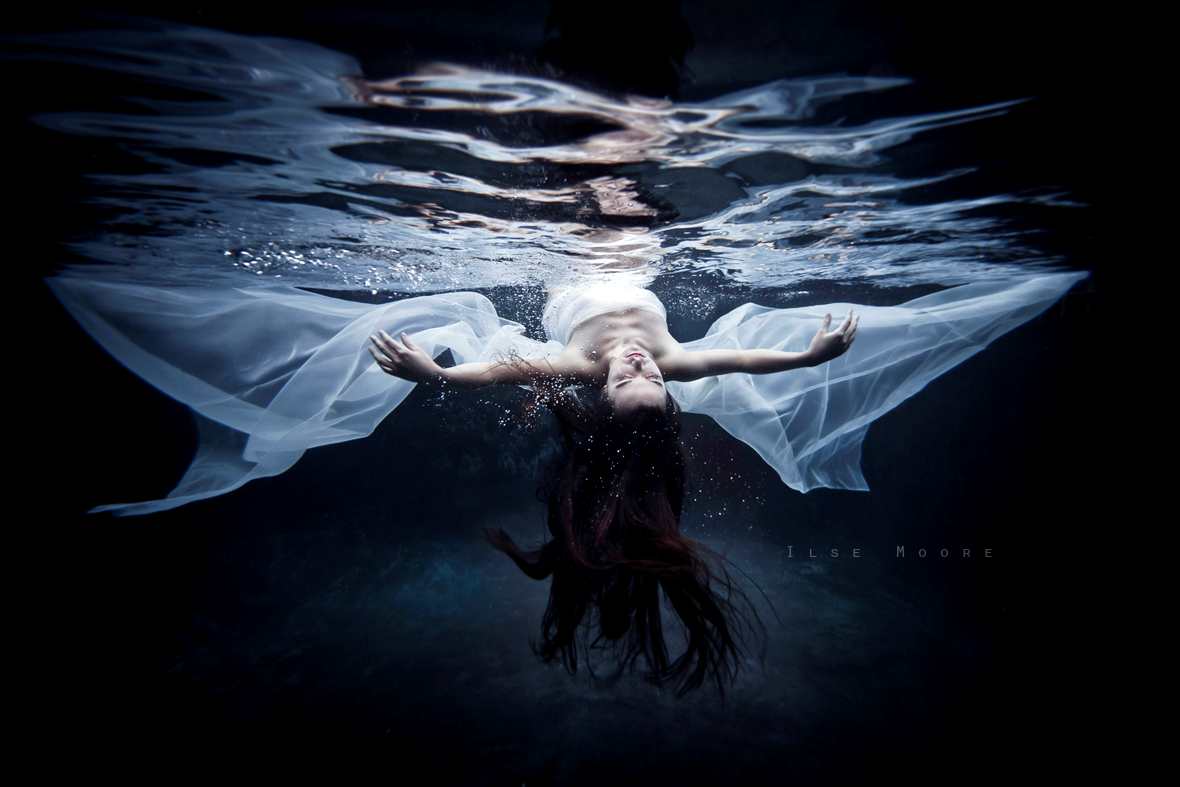
~~~~~~~~~
Gripping the Wheel.
My heart races along with the sound of passing cars.
My lungs fill with air.
Didn’t realize I was holding my breath until I exhaled—and felt my world stop.
I loosen the grip of my hands from the steering wheel.
Tiny red blotches—some that have bled open—contrast the stark whiteness of my hands.
My skin—so thin—blue velvet veins—shroud in translucency.
A persistent reminder of my disability—visibly hiding within.
My body is solitary. I don’t recognize myself.
Along the gravel shoulder I have stopped—to breathe.
Slowly I draw back out of auto-pilot, carefully surveying the surrounding traffic around.
All I can see—all I can feel—are vehicles rushing past me.
Life races past me and through me.
In the blink of someone else’s watchful eye.
From myself I am severed—disconnected—without feeling.
I drive home in tranquility.
The sun sets upon me.
~~~~~~~~~
After writing “Gripping the Wheel,” thoughts of my storied life and the storied lives of my ancestors—bleeding—mad—dying—brave and strong—ripple through my veins. I think about my fear—of being labeled and placed into the category of other. I think about my identity and how I never questioned—until I got sick—who I once was, who I am now, and who I am learning to become. I think about my body and what it feels like to be bleeding through the outside in. I start to feel tired and drained as though my blood is seeping out—through my skin—in my hair—trickling down my neck. I envision myself sleeping in a gentle pool of water. Water washing over me—trickling around me—cleansing me—christening me—healing me. I think about my mother’s deteriorating health as blood drains through her like a sieve. Anemia has made her weak, confused, and emotional. It is difficult for me to communicate with her at times. As her medical team conspires to remedy her with a regime of blood transfusions, I am conflicted. I question my mother’s reasoning for holding onto a life that quietly bleeds her to death. I think, what does this mean for myself, born with the same genetic bleeding disorder? Will I be forced to live out the same legacy as my mother? What if I don’t want treatment? What if I don’t see myself as broken or needing to be fixed with someone else’s blood pumping through my veins? From the internet, I find a new image (see fig. 2), another photograph by Ilse Moore (n.d.). Somehow, it captures the feelings I can’t express in words. The photograph is of a woman suspended underwater in a sea of blackness. Draped in crimson fabric, with her back arched and head pointing down, the woman looks like she is floating in a veiled pool of blood. I begin to write, “Bleeding from the Outside In.”
~~~~~~~~~
Bleeding from the Outside In.
As a child and teenager, I recall several incidents where I saw both my mother and grandmother bleeding—a lot. From the nose, mouth, gut, and even skin—always so much blood. The spontaneity and intensity of these episodes terrified me. As I see the solutions through images, I feel the answers in my skin—pulsing through my veins. Feeding my soul—my being—my essence—I am lost—in thought, as my thoughts become life where words do not convey, in adequacy, its meaning.
~~~~~~~~~
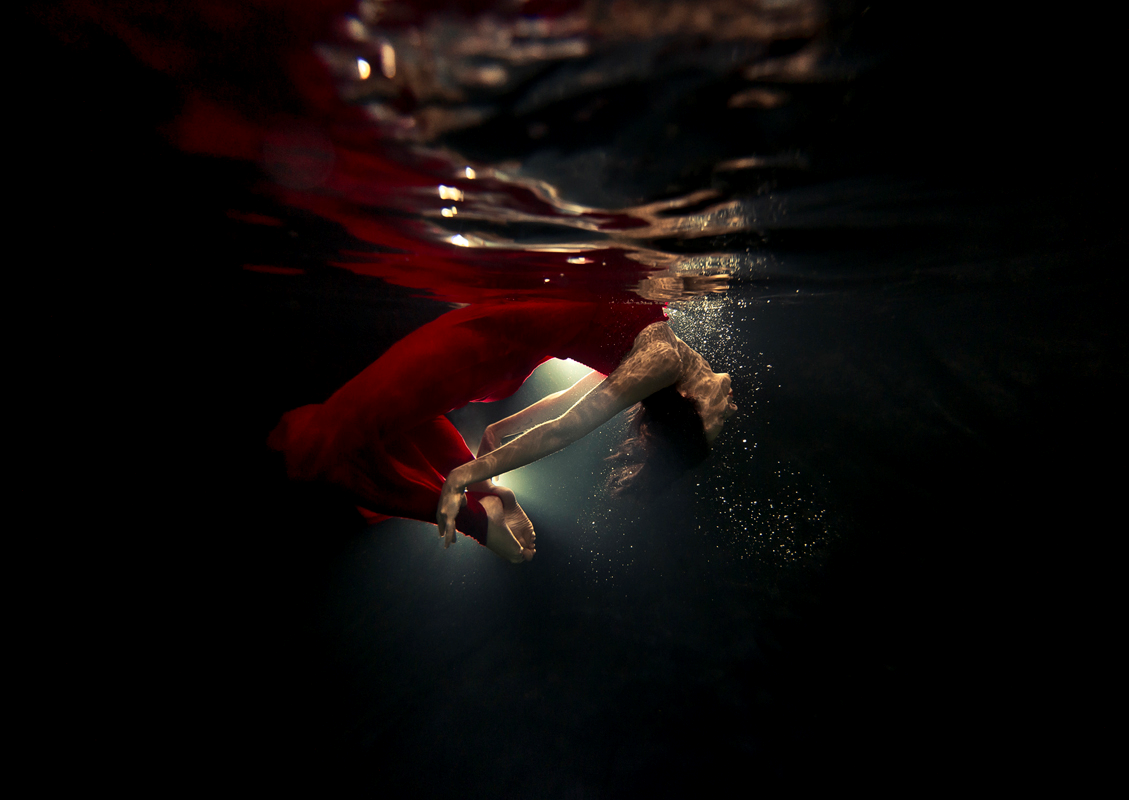
For years I tried to hide the secret of my health conditions, my life with a genetic bleeding disorder and relapses of mental illness, but then I experienced a series of small strokes which later triggered a severe relapse of mental illness. Almost two years after I had recovered from my strokes, I begin to write about the experience of waking up trapped inside my body. Before putting pen to paper, I search the internet to find an image that somehow embodies the disorientation I once felt. I select a photograph (see fig. 3) by Elena Kalis (n.d.). It is of a woman underwater. Her legs are turned up towards the surface while her head sinks deep into darkness. I begin to write, “Trapped Inside My Body”.
~~~~~~~~~
Trapped Inside My Body.
That morning, upon waking, my body trapped me inside. From its solid icy grip—skin—flesh—and bones—my body failed to unleash me to movement.
Relentlessly—restlessly—a fog of disorientation strikes me helpless. Unable to move—unable to make sense of my body in relation to my bed, the floor, and the walls of the room that encase me, I wrestle—without motion—in the cemented weight of my body. I am stuck in some sort of space—halfway under—not sure how to surface. Staring down at my body— outside of myself somehow—I pause. An intensity of pain shoots deep through the left side of my head. Like the impale of a lance—gravely burrowing into my brain—its position holds strong. Then, somehow—somewhere—in the seconds of an eternity—it fades away—like a dormant haze. Only after the pain passes am I aware that my breath and beating heart had stopped. I am exhausted. My head sticks to my bed. My hair is glued to the pillow which is encrusted in dark crimson blood. My nose must have bled through the night. I am tired—so very tired. I want to get up out of my bed, but I can’t. I try to move my right arm but it feels so heavy. I try to call for help, but words get stuck in my head and on my lips. I try to lift myself out of bed but instead I fall to the floor. My son must have heard me fall because he called for an ambulance. I remember being in the ambulance—on a stretcher. My feet felt cold. From the hospital bed, in the distance, I hear a toilet flush. Its sound—the note of a body working—contrasts my own body stopped.
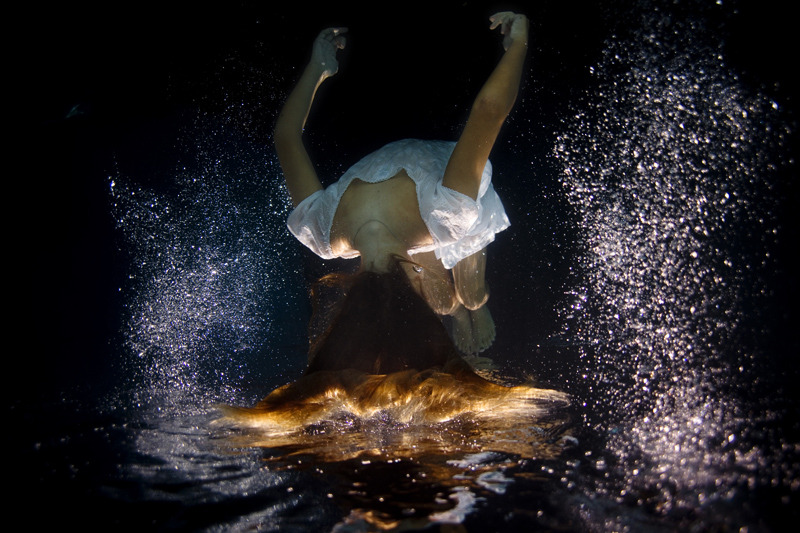
~~~~~~~~~
Within a few weeks of my strokes as I regain my senses, I start to struggle with depression. I am coming to terms with the fact that my body has changed—that I have changed. Tasks once so simple now take their toll. Sometimes just walking upstairs wears me out. I take the elevator a lot. My physical inactivity causes me to gain weight. It is tough maintaining the busy pace I once relished. From the internet, I find another photograph (see fig. 4) by Elena Kalis (n.d.). It is of a woman underwater—hair swirling around her head. She is holding a tortoise shell in front of her chest; fused to the underside of the shell, exposed are its backbones. I select this photograph as an embodiment of my empty emotions. Revealing the brokenness of my inner self, I begin to write “The Blood, Bones, and Guts of My Emotions”.
~~~~~~~~~
The Blood, Bones, and Guts of My Emotions.
In retrospect, I now realize that this series of strokes may have affected me more dramatically than I cared to consider at the time. I feel sad and embarrassed—realizing how sick I really was. Perhaps I was in a state of shock. Perhaps it was easier to submerse myself into denial than accept the fact that my body was changing—that I was changing. Perhaps I wanted to dissociate myself from the fear of living in a body that was broken. I regret having exposed my fractured self and fractured mind to my colleagues and friends. It must have been confusing and difficult for them to see me as I was—a shell of a person with the blood, bones and guts of my emotions flailed on display.
~~~~~~~~~
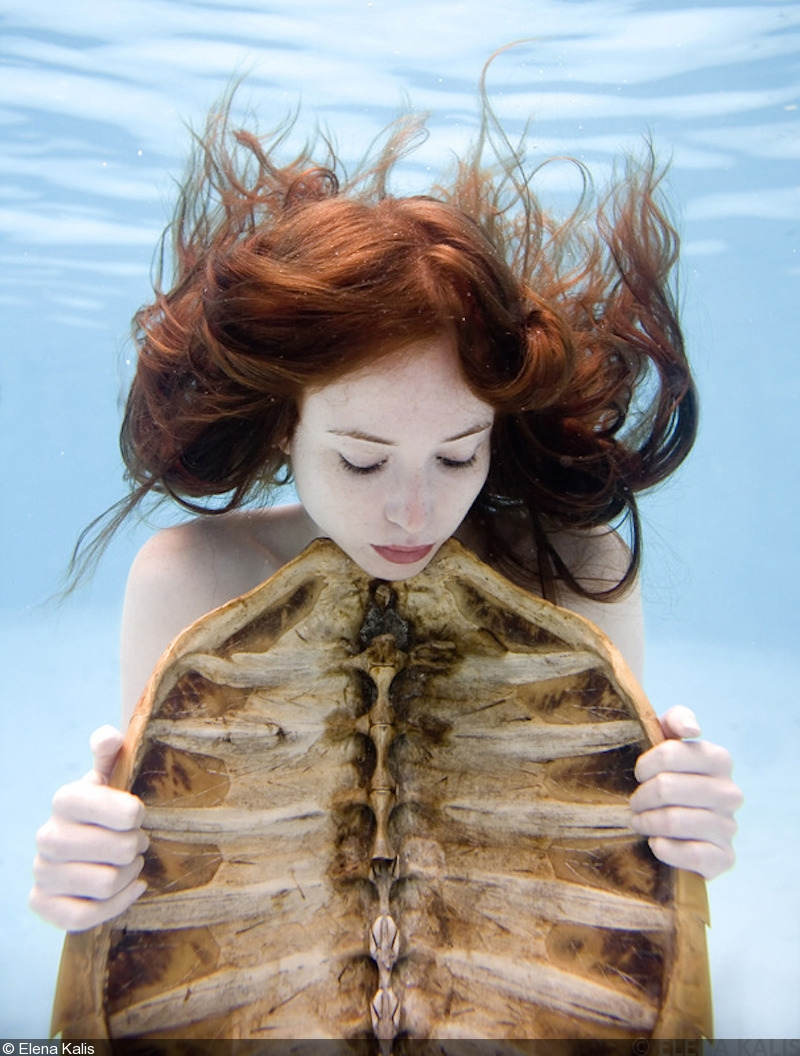
Struggling to make sense of my experiences, I try to make myself feel whole by regaining my thoughts. As surface tensions escalate, my body weighs down to the depths that lie below. I am forced to delve under to discover what lies beneath. It is a difficult process—trying to fill in the gaps. I feel like a child. I am curled up in a ball. From the internet, I find a photograph (see fig. 5) by Ilse Moore (n.d.) that embodies my fear and confusion. The photograph is entitled “Lightness and Darkness”. It is of a woman underwater. She sits crouched, curled up, at the bottom of a black sea. Although her body wears a white slip, she looks naked in the reality of loneliness. I begin to write “Filling in the Gaps”.
~~~~~~~~~
Filling in the Gaps.
Filling in the gaps is painful; they are entrenched in the rawness of life’s flawed edges.
Gaps make my head hurt.
Gaps make my heart ache.
Gaps hold insight into past experiences that have left me hurt, puzzled and confused.
Gaps make me feel broken, helpless, and ashamed.
~~~~~~~~~
Seeing those words in text, somehow, helps me find voice. I am tired of living in a body that cries an invisible identity; an identity that I have struggled to carry and conceal for the most part of my life. From passivity to activity, resilience and freedom of spirit, again, I turn to the language of imagery. Spry (2011) refers to this type of methodological process, where:
analysis, composition, and performance are deemed interdependent through the concept of textualizing body where no epistemological hierarchy exists between page, stage, word, or body; the body/self, the autoethnographic text, and the performance of the text contribute equally to the meaning making process … [where] performance is not an added scholarly bonus … [it] does not “illuminate” the text, rather it assists in the creation of the text, and it is itself performative. (pp. 28—29)

Using the language of imagery, selected from the internet, I find another photograph (see fig. 6) by Ilse Moore (n.d.) entitled “Dancers and Warriors”. It depicts a woman underwater wrapped in sashes of darkness and light. With her body positioned upright embracing the whirling waves pushing her up towards the surface, the woman leans forward to reveal the majesty of her silver opalescent wings. In a way that counters the present rhetoric/metaphor of dis/ability as something that war must be waged against, I select this photo to embody my warrior salvation—rising up and above—sensing life in its completeness. I begin to write, “I Am a Nighthawk”.
~~~~~~~~~
I Am a Nighthawk.
I am a nighthawk.
Not an owl—but a hawk.
I am a bird that soars through the sky—alone—making no nest my home.
I work in the wee hours of the night—by the flicker of a candle
or by the glow of the TV light.
The sound of the keys clicking and tapping. I type faster and faster and faster.
The space bar plunking down harder and harder.
When I feel that the words are right—right to write—then I am free and can type super
F-A S-T.
I love the night hawk—that doesn’t travel in a flock.
It surveys the world from above from afar—with its terrifying squawk.
Its call so distinct—so succinct to the mood of the night and to the beat of my heart.
I watch in splendor as it circles above. The hair on the back of my neck stands straight.
I feel the intensity of its focus—thriving—diving—its swoops to the ground for its prey,
but only for a flash.
Like the glare from the morning sun across the stony water ripples—cold.
And so, the night hawk soars bold—never dying away—never controlled.
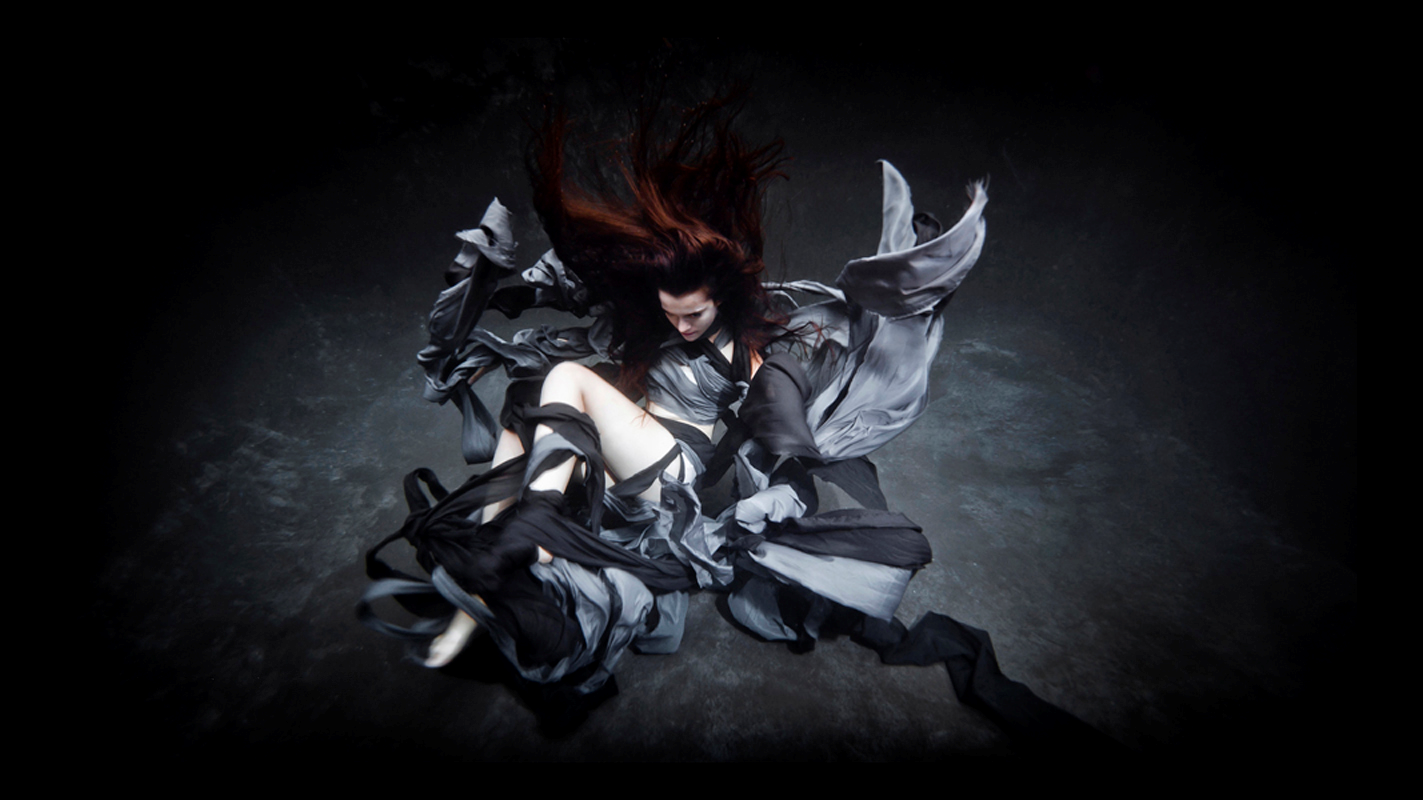
~~~~~~~~~
In solitude, restless and relentless, an identity of presence takes transformation that overcomes my struggle to find words to make sense of my dis/ability experiences. Like a bird that spreads its wings high in the sky, I feel the presence of being in the moment where I am free to explore. I think about what it would feel like if my body had no flesh, no blood, nor bones. From the internet, I find one last image (see fig. 7). It is a photograph by Elena Kalis (n.d.). In it, a woman’s body is seen in an underwater kaleidoscope of colour and light. She is walking along the sandy ocean bed with her head hidden above the surface. She is wearing a short red dress that swirls around her legs as the sun glimmers through the water’s surface. I begin to write, “Living in the Skin that I Am.”
~~~~~~~~~
Living in the Skin that I Am
Submerged underwater I see the beauty of the sparkling sunlight peeking through the surface as I look up from below.
It is like a crystal sky.
I am comforted and mesmerized by its beauty—its tranquility.
I never want to surface again.
I want to stay submerged in God’s glory.
Here—in the cool waves that surround me—I am beautiful—I am free.
Surfacing only brings me closer to the painful reality of having to breathe—again.
I do not want to feel the world through my burning skin—through my aching bones—
through my bleeding body and tired head.
I am alone—in this body.
Trudging myself—my skin—my bones—my blood—my flesh—through life.
All of me can so easily be altered—changed—through the absent beat of a heart, in the
crash of a car, through the decay of cancer.
What would I look like without skin? Without bones, blood, or flesh?
I think I would be beautiful and free like Mother Earth.
~~~~~~~~~

Unmaking the Pantomime
Having lived constricted in a dis/ability paradigm, I have come to appreciate life—in ability and disability—as one and the same on the continuum of experience. As an adult educator with non-apparent dis/abilities, the temporality of my narrative is framed before and after my encounters and relapses with stroke and mental illness. Dimensions of my narrative parallel Spry’s (2011) metaphoric model of performative autoethnography using body, paper, and stage. In the narratives of “Gripping the Wheel,” “Bleeding from the Outside In,” “The Blood, Bones, and Guts of My Emotions,” and “Filling in the Gaps,” I write about the heritage of my body’s secret identity—broken and disconnected in mind and spirit. Chilling poetry that describes the fear of living in the skin that I am, is the stage from which my body is described through experience. Spry described how the body is tantamount in autoethnographical work, especially in the experience of loss and healing. Spry stated, “it is the presence and absence of bodies that constitute the experiential evidence of loss” (p. 20). In loss of myself, in recognition of my different self, by writing the narrative of my hidden identity, I took the first step towards embracing my dis/abled identity.
In a vein that moves my identity from a place of passivity to one of activity, “Trapped Inside My Body” exposes the heart bleed of my vulnerability in the face of physical and emotional identity change. Offering insight into the experience of loss of self, through embodied writing, this sense-making narrative is critical to my identity construct. In expressing my body’s brokenness, my knowledge surfaces as raw emotion, intuition, and instinct. This surfaced embodied understanding fuels a source of empathetic connection between my dis and abled identity, as new knowledge is constructed and reconstructed in the process of critical self-reflection.
In the reconstruction of my experiences with dis/ability through narrative, waves of memories, feelings, emotions, and thoughts surfaced within me and swirled around me. Dispersed throughout the narrative text, visually captivating, artistic photographs of women underwater played a key role in my autoethnographic performance of “body, paper, and stage” (Spry, 2011). In the poems “I Am a Nighthawk,” and “Living in the Skin that I Am,” I write about the presence of being in the moment, in the cloaked shadows of nighttime, alone and connected to the silent world surrounding me. Where words felt scare in their delivery, the power of my vulnerability was embodied through the performance of image. Spry (2011) acknowledged this aspect of autoethnographic performance, where words seem to fall short, by stating that:
words may fall about us we may sometimes lurch within the boundaries of performance only to stumble upon a shard of language telling the messy beauty of being with others; old grammars of fear may fracture under the weight of oppression leveled upon us – or that we have leveled upon others. The process of writing and performing critical autoethnography, or performative autoethnography as it will be conceptualized here is the continuous negotiation of account for who we are with others in culture on page and stage and back again. (p. 27)
Before I ventured into the performance of autoethnography, my world felt mostly black or white. I was stuck in a mindset where I felt broken—helpless because I didn’t fit neatly into a box—hopeless because I had been placed in a box that I wanted to escape from. Through the interactive process of critical self-reflection and dialogic narrative, layers of the skin that I live in have been ripped open, examined, and stitched up. Through the deconstruction and reconstruction of my patchwork storied life, I can appreciate that voice assume different modalities—on paper, in body, and on stage. Voice may be heard, seen, felt, and experienced. Voice may echo in silence, and voice may quietly roar. Voice may take the form of colouring neatly within the lines, or voice may appear scattered in its creation through difference—in the beauty of art. In my autoethnographic cartography of dis/ability construct, I have gained greater insight about what it means to be human and how it feels to be whole.
References
- Docherty-Skippen, S. M. (2014). Living in the skin that I am: An organizational autoethnography of an adult educator's plight to survive the stigma of invisible and episodic disability in an academy of administritiva. Brock University Digital Repository.
- Ellis, C., Adams, T., & Bochner, A. (2011). Autoethnography: An overview. Forum: Qualitative Social Research, 12(1), Art. 10.
- Grant, A., & Zeeman, L. (2012). Whose story is it? An autoethnography concerning narrative identity. The Qualitative Report, 17(36), 1-12.
- Hodges, C. E., Fenge, L. A., & Cutts, W. (2014). Challenging perceptions of disability through performance poetry methods: the ‘Seen but Seldom Heard’project. Disability & Society, 29(7):1090-1103.
- Kafai, S. (2012). The Mad border body: A political in-betweeness. Disability Studies Quarterly, 33(1).
- Kalis, E. (Photographer). (n.d.). “Underwater_dark01” [digital photograph]. Retrieved from: http://www.elenakalisphoto.com/dark-water/
- Kalis, E. (Photographer). (n.d.). “Underwater_elena_kalis21” [digital photograph]. Retrieved from: http://www.elenakalisphoto.com/myportfolio/
- Kalis, E. (Photographer). (n.d.). “Underwater_elena_kalis55” [digital photograph]. Retrieved from: http://www.elenakalisphoto.com/myportfolio/
- Kuppers, P. (2001). Deconstructing images: Performing disability. Contemporary Theatre Review, 11(3-4):25-40.
- Moore, I. (photographer). (n.d.). “Dancers and Warriors” [digital photograph]. Retrieved from: http://www.ilsemoore.com/portfolio/fine-art/fine-art/
- Moore, I. (photographer). (n.d.). “Lightness and Darkness” [digital photograph]. Retrieved from: http://www.ilsemoore.com/portfolio/fine-art/fine-art/
- Moore, I. (photographer). (n.d.). “Natalia” [digital photograph]. Retrieved from: http://www.ilsemoore.com/portfolio/fine-art/fine-art/
- Moore, I. (photographer). (n.d.). “The Immortal” [digital photograph]. Retrieved from: http://www.ilsemoore.com/portfolio/fine-art/fine-art/
- Ricoeur, P. (1975). Phenomenology and hermenutics. Nous, 9(1):85–102.
- Spry, T. (2011). Body, Paper, Stage: Writing and Performing Autoethnography, Walnut Creek, California, Left Coast Press Inc.
- van Manen, M. (1982). Phenomenological pedagogy. Curriculum Inquiry, 12(3):283–299.
- van Manen, M., Higgins, I., & van der Riet, P. (2016). A conversation with Max van Manen on phenomenology in its original sense. Nursing & Health Sciences, 18(1):4–7.